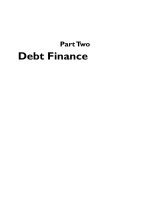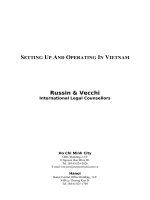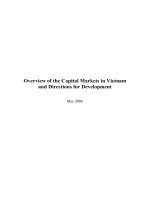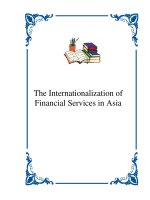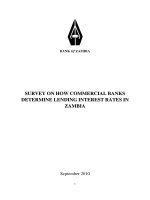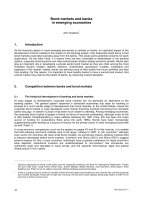Corporate bond markets in Asia doc
Bạn đang xem bản rút gọn của tài liệu. Xem và tải ngay bản đầy đủ của tài liệu tại đây (57.55 KB, 11 trang )
BIS Quarterly Review, December 2005
83
Jacob Gyntelberg
+852 2878-7145
Guonan Ma
+852 2878-7015
Eli M Remolona
+852 2878-7150
Corporate bond markets in Asia
1
Corporate bond markets in Asia differ widely in size. Some primary markets
have opened up to foreign issuers while others have relied on quasi-
government issuers. Secondary markets often suffer from illiquidity, due in
varying degrees to narrow investor bases, inadequate microstructures and a
lack of timely information about issuers.
JEL classification: G140, G180, M400, O160.
Since the 1997 Asian financial crisis, bond market development has become a
high priority for Asian policymakers. The development of local currency bond
markets has often been seen as a way to avoid crisis, with these markets
helping reduce potential currency and maturity mismatches in the economy.
Indeed, several Asian economies have succeeded in developing fairly active
primary and secondary markets in domestic government bonds.
In recent years, policymakers in many Asian economies have started to
turn their attention to local currency non-government (“corporate”) bond
markets. They recognise that a robust financial system requires multiple
channels of financing, in which banks and other types of investor compete for
borrowers. As the Asian financial crisis itself demonstrated, short-term credit
markets are prone to creditor runs, and a corporate bond market can provide
an economy with an important source of long-term finance.
2
While the primary markets for corporate bonds in Asia have grown
significantly, the growth in some cases seems to have been driven largely by
quasi-government issuers or issuers with some form of credit guarantee. These
markets may have developed in this way because investors have had little
access to the kind of information that would allow them to adequately evaluate
1
The views expressed in this article are those of the authors and do not necessarily reflect
those of the BIS. We thank Claudio Borio, Muhammad Ibrahim, Kim Ng, Indra Sakti, Jeong-Ho
Suh, Jim Turnbull and Frank Packer for helpful comments and discussions.
2
In Greenspan’s (2000) words, a functioning capital market might have provided the Asian
countries with a “spare tire” and made the crisis more benign. Diamond (2004) shows formally
why it is in the nature of short-term credit markets to be prone to creditor runs.
84
BIS Quarterly Review, December 2005
the credit risks of other potential issuers. The secondary markets have
developed less, with relatively little trading activity to be seen in many markets.
Here we suggest that this inactivity may stem from a combination of a lack of
investor diversity, inadequate market microstructures, market opaqueness and
insufficient flows of timely information to creditors.
In what follows, we first describe primary corporate bond markets in
Asia-Pacific in terms of their size and issuer composition. We then characterise
the secondary markets and suggest reasons for the lack of liquidity in some of
these markets.
Primary markets: size and composition
Relying on statistics from the BIS as well as data from Dealogic Bondware, we
characterise the size and composition of the markets for local currency
corporate bonds in Asia-Pacific. These markets include the currencies of
Australia, China, Hong Kong SAR, India, Indonesia, Japan, Korea, Malaysia,
New Zealand, the Philippines, Singapore and Thailand. We define “corporate
bonds” to include all non-government long-term debt issues in a given
currency. We include quasi-government issuers, financial and non-financial
issuers and both resident and non-resident issuers.
Market size, liquidity thresholds and crowding-out
At the end of 2004, the 12 local currency markets included in this study had
corporate bonds outstanding of almost $3 trillion. The Japanese market alone
is $2 trillion in size, accounting for two thirds of the total (Table 1). Behind
Japan are three markets that can still be considered relatively large: Korea with
$355 billion, China with $196 billion and Australia with $188 billion. These four
markets are “large” in the sense that they exceed the $100 billion threshold
estimated by McCauley and Remolona (2000) as the size that would tend to be
required for a deep and liquid government bond market.
3
Because corporate
bond issues are by definition more heterogeneous than those of government
bonds and issue sizes smaller, such a threshold for corporate bond markets
would tend to be much higher. Factors other than size that would affect liquidity
are discussed in the second part of this special feature.
Whatever the actual liquidity threshold, the remaining corporate bond
markets would seem to have far to go to reach it. The next largest market is
Hong Kong with $62 billion, followed by Malaysia with $50 billion, Thailand with
$32 billion, New Zealand with $30 billion, India with $24 billion and Singapore
with $22 billion. Two other economies – Indonesia and the Philippines – have
even smaller markets. As discussed below, opening up to foreign issuers and
investors may help a market overcome the disadvantages of a small size.
The size of the market would depend not only on the size of the economy
but on the level of its development. In addition, market size may be affected by
3
This is, of course, only a rough threshold and it does not take into account a number of other
factors that would affect liquidity.
Crowding-out of
issuers or investors
Four markets
qualify as large
BIS Quarterly Review, December 2005
85
competition among financing alternatives on either the issuer or investor side.
While a banking sector or equity market would compete with the debt securities
market for the same potential corporate issuers, the financing of large
government budget deficits may crowd out potential investors. Still, it is not
surprising that the deepest corporate bond markets are those of the higher-
income economies of Australia, Hong Kong, Japan, Korea, Malaysia and New
Zealand. In each of these cases, as shown in Table 1, the size of the market
exceeds 25% of GDP. It is also unsurprising that the shallow markets relative
to GDP are those of the lower-income economies of China, India, Indonesia
and the Philippines.
Composition of issuers
The types of issuer we find in a given market may give us a sense of how well
developed the markets are in the 12 currencies. The natural issuers in a
corporate bond market are the large firms, for which investors would find it
worthwhile to evaluate their credit quality based on publicly available
information. Hence, beyond the size of a market, a measure of its development
would be the range of credit quality of the borrowers that come to the market.
At the same time, the presence of non-resident issuers may represent a vote of
confidence, indicating a market that is able to provide funds on terms that are
competitive with those available in other currencies.
In Asia, issuers in some markets still seem to be concentrated near the
high end of the credit quality spectrum. In Malaysia, about 40% of the market
consists of issuers with the local ratings of triple-A and another 40% of issuers
Size of corporate bond markets and other channels of local currency funding
At end-2004
Corporate bonds
1
Other channels as a percentage of GDP
Amounts
outstanding
(USD billions)
As a percentage
of GDP
Domestic credit
Stock market
capitalisation
Government
bonds
outstanding
Australia 187.5 27.1 185.4 111.5 13.8
China 195.9 10.6 154.4 33.4 18.0
Hong Kong SAR 61.9 35.8 148.9 547.7 5.0
India 24.5 3.3 60.2 56.8 29.9
Indonesia 6.8 2.4 42.6 24.5 15.2
Japan 2,002.0 41.7 146.9 76.9 117.2
Korea 355.6 49.3 104.2 74.7 23.7
Malaysia 49.7 38.8 113.9 140.8 36.1
New Zealand 29.9 27.8 245.5 41.1 19.9
Philippines 0.2 0.2 49.8 37.5 21.8
Singapore 21.7 18.6 70.1 211.4 27.6
Thailand 31.9 18.3 84.9 67.1 18.5
Memo: United States 15,116.6 128.8 89.0 138.4 42.5
1
Defined as bonds and notes issued in the country’s currency by either residents or non-residents, in both domestic and international
markets.
Sources: IMF; World Federation of Exchanges; Dealogic Bondware; national data; BIS. Table 1
86
BIS Quarterly Review, December 2005
with double-A ratings. In Korea, some 80% are single-A or above.
4
In the
absence of more systematic data on the credit quality of issuers in the different
markets, we can turn to indirect evidence in the form of the division of issuers
into quasi-government issuers, financial institutions and non-financial issuers.
Quasi-government issuers are likely to borrow with government guarantees,
whether explicit or implicit.
5
Hence, they are likely to have the highest credit
quality available in the country. As shown in Graph 1, quasi-government
issuers dominate three of the markets: China, India and New Zealand. It should
be noted that since the Asian crisis, the Korean market has graduated from one
dominated by issues backed by credit guarantees to one in which such issues
are a negligible fraction.
While financial institutions often have implicit guarantees, this does not
seem to be the case in the markets dominated by such institutions: Australia,
Hong Kong, Korea and Singapore. In fact, the pattern of financial issues
making up the larger part of the market is no different from that in European
markets, and at least in the case of Australia many of the financial issues are in
fact asset-backed securities.
A further indication of the importance of quasi-government issuers in
Asian corporate bond markets is the composition of the HSBC Asian Local
Bond Index (ALBI). The index is designed to track the performance of liquid
local currency bonds in China, Hong Kong, India, Indonesia, Malaysia, the
Philippines, Singapore, Taiwan (China) and Thailand. It has a large number of
4
Ratings composition estimates based on information provided by Bank Negara Malaysia and
the Bank of Korea. For comparison, the US market has its highest concentration of corporate
issuers in the single-A grade category, followed by the triple-B grade category.
5
Here we include in our quasi-government categories supranational issuers such as the Asian
Development Bank (ADB) and the International Bank for Reconstruction and Development
(IBRD), municipal bonds and a number of foreign quasi-government financial institutions such
as the US agencies.
Outstanding issues in corporate bond markets by type of issuer
In per cent
0
20
40
60
80
100
AUD CNY HKD IDR INR JPY KRW MYR NZD PHP SGD THB
Quasi-government¹
Financials and ABSs
Non-financial private
1
Includes municipal issuers, supranational issuers such as the World Bank and foreign quasi-government
institutions such as the US agencies.
Sources: Dealogic Bondware; BIS calculations. Graph 1
Quasi-government
issuers dominate
three markets
BIS Quarterly Review, December 2005
87
constituent issues and includes non-government ones. Significantly, however,
these “non-government” constituent issues are restricted to those by quasi-
government borrowers.
The evidence presented above is incomplete and indirect, but it does give
a strong sense that issuance in at least a few of our 12 markets is dominated
by issuers with high credit quality. In the markets where this pattern persists, it
is likely that institutional investors have internal guidelines that limit them to
investing only in highly rated securities. Nonetheless, such guidelines may
merely reflect the fact that the publicly available information may not be
adequate for investors to assess the creditworthiness of potential issuers with
significant default risk. Indeed, this possibility is supported by Bhattacharya et
al (2003), who report measures of the opacity of earnings releases that tend to
be higher for Asian countries. Moreover, Fan and Wong (2002) argue that such
releases in Asia tend to be less informative because of cross-holdings and
pyramid ownership structures.
As discussed earlier, the presence of foreign issuers may indicate how
well developed a market is. It may also reflect the efforts of policymakers in a
small economy to find ways to enlarge their market and make it more viable. As
shown in Table 2, the New Zealand, Hong Kong and Singapore dollar markets
host the highest proportions of non-resident issuers, with these issuers
comprising 86%, 56% and 36% of the market respectively. The Australian
dollar market also has a relatively high proportion of 28%. These proportions
include non-residents who issue local currency bonds offshore, in London for
example. Also, data on onshore and offshore issuance are not fully comparable
and so these proportions might overstate the non-resident share. Nevertheless,
they suggest that, by this metric, these four markets may be the best
developed in the region.
Local currency corporate bonds by residence of issuer
1
At end-2004
Residents
(USD billions)
As a percentage
of total
Non-residents
(USD billions)
As a percentage
of total
Australia 134.0 71.5 53.5 28.5
China 195.9 100.0 0.0 0.0
Hong Kong SAR 27.3 44.1 34.6 55.9
India 24.5 100.0 0.0 0.0
Indonesia 6.8 99.8 0.0 0.2
Japan 1,646.1 82.2 355.9 17.8
Korea 355.2 99.9 0.4 0.1
Malaysia 49.5 99.6 0.2 0.4
New Zealand 4.1 13.8 25.8 86.2
Philippines 0.2 86.8 0.0 13.2
Singapore 13.9 64.0 7.8 36.0
Thailand 31.8 99.8 0.1 0.2
Memo: United States 13,535.9 89.5 1,580.7 10.5
1
See footnote 1 to Table 1 for definition of corporate bonds.
Sources: Dealogic Bondware; BIS. Table 2
Is the available
public information
inadequate?
Foreign issuers a
vote of confidence
88
BIS Quarterly Review, December 2005
Secondary markets
Liquidity in corporate bond markets
Before considering the problems of liquidity in the Asian markets, it is worth
keeping in mind that even a large market such as that of the United States is
not perfectly liquid either. There, liquidity is concentrated in the so-called
“benchmark” bonds. Most other corporate bonds are traded actively only in the
first few weeks after issuance as part of the “allocation process”. After this
period, liquidity is typically low, with two-way pricing provided by a few market-
makers, primarily the lead underwriters of the issue. Whereas bid-ask spreads
in the inter-dealer market for US Treasury securities are less than 1 basis
point, bid-ask spreads in the corporate bond market are about 3 to 5 basis
points.
6
In recent years, the introduction of standardised credit default swap
(CDS) indices in North America has added greatly to the liquidity of the
underlying names.
7
Still, these indices are limited to only 125 names each.
This experience demonstrates how challenging it is to create liquidity even in
very developed corporate bond markets.
The secondary markets for local currency corporate bonds in Asia have
also lagged behind their government bond counterparts. While in the last few
years government bond markets and in some cases swap markets have
become reasonably liquid, corporate bond markets remain relatively illiquid in
Asia. The turnover ratios in most Asian corporate bond markets are typically a
smaller fraction of that of their government counterparts than is the case in the
United States (Graph 2).
Four salient factors appear to be keeping liquidity low in the Asian
corporate bond markets: a lack of diversity in the investor base, inadequate
market microstructures, market opaqueness and a limited flow of timely
information about issuers to creditors. We discuss each of these factors below.
Diversity of investor base
A diversity of investors fosters trading activity. With such diversity, it becomes
less likely that different investors will find themselves on the same side of the
market, either as sellers or buyers. They are more likely to disagree on the
credit quality of an issuer and thus be more willing to trade, and they are less
likely to need liquidity at the same time. In Asia, such diversity seems to be
rather limited. Here the investor base for corporate bonds tends to be
dominated by government-controlled provident funds, insurance companies
and banks. Once a bond is issued, it normally disappears into the portfolios of
buy-and-hold investors. Those who might trade more actively, such as fixed
6
Fleming and Remolona (1999) calculate the bid-ask spread for US Treasury securities to be
between a sixth and a third of a basis point on the yield. Chakravarty and Sarkar (2004)
estimate the average bid-ask spread of corporates to be about 21 cents per $100. For a five-
year bond, this amounts to about a 4 basis point bid-ask spread on the yield.
7
These indices include the DJ CDX Index in North America. See Amato and Gyntelberg (2005).
Corporate bond
markets in Asia
relatively illiquid
Even the largest
markets are not
perfectly liquid
BIS Quarterly Review, December 2005
89
income funds and hedge funds, are typically missing from these markets or are
only allowed very limited credit risk exposures.
An important class of investors that is missing from some Asian markets is
foreign investors, including global financial intermediaries. In general, myriad
market impediments discourage them from participating in the local markets.
Among the impediments are withholding taxes and the lack of a market for
hedging instruments, such as currency swaps. Policymakers in Asia are aware
of these. In setting up the Asian Bond Fund 2 (ABF2), as Ma and Remolona
(2005) explain, central banks in Asia were able to reduce some of these
impediments. The Philippines, for example, recently removed documentary
stamp taxes on the secondary trading of fixed income securities, which had
discouraged foreign investors from participating in its local market.
Market type
Fixed income debt securities tend to trade more actively on over-the-counter
(OTC) markets than on exchanges.
8
The most liquid OTC markets are those
for government securities, which tend to rely on designated market-makers, as
discussed by Sundaresan (2002). Inter-dealer brokers allow dealers to trade
with each other anonymously. Such microstructures have often required
government encouragement to establish. In China, India, Japan, Korea,
Malaysia, Singapore and Thailand, as in the United States, such primary
dealers and market-makers for government securities are appointed by the
authorities and required to make markets for government securities. Compared
to government bonds, corporate bonds are handicapped by the fact that issues
tend to be rather heterogeneous and issue sizes to be smaller. Hence, they
8
OTC markets are said to be “quote-driven” markets requiring dealers willing to maintain
inventories, while exchanges are often “order-driven” markets requiring a continuous flow of
buy and sell orders.
Turnover ratio
1
In per cent
0
2
4
6
8
AU IN
JP KR MY NZ TH
US
Government
Corporates
32.3
1
Annual turnover excluding repos divided by end-of-year outstanding for local currency domestic markets.
Sources: Reserve Bank of Australia; Bank of Korea; Bank Negara Malaysia; Reserve Bank of New
Zealand; Bank of Thailand; Australian Financial Markets Association; NSE India; Japan Securities Dealer
Association; Bond Market Association of the United States. Graph 2
Government has
role in setting up
microstructures
Important class of
investors missing
90
BIS Quarterly Review, December 2005
may require even more help from the authorities in removing obstacles to the
provision of liquidity as well as setting up microstructures.
In Asia, efforts to foster liquidity in corporate bonds have included having
them listed on existing stock exchanges or even the setting-up of exchanges
devoted to fixed income securities. Such measures are often also aimed at
improving transparency. However, trading so far remains concentrated in the
OTC market. In Seoul, for instance, over 90% of the secondary trading in
corporate bonds still takes place in the OTC market and only 10% on the
exchange. In Thailand, the turnover ratio has been 30% in the OTC market and
only 1% on the local exchange. In China, because of regulatory fragmentation,
financial issues have been traded only on the local interbank OTC market,
while non-financial names have been traded either on the two domestic stock
exchanges or on the interbank OTC market.
Several of the Asian secondary markets for corporate bonds tend to be less
competitive, resulting in wide bid-ask spreads that discourage trading. Market
participants suggest that bid-ask spreads in many of the Asian markets are about
5 to 10 basis points even for the most liquid issues (Table 3). In a number of
markets, there tend to be one or two dealers for a single issue, often the lead
underwriters. In addition, while indicative quotes from dealers are sometimes
available on Bloomberg, in many markets ex ante transparency consists of different
dealers faxing quote sheets to potential investors, which often contain only a limited
and non-comparable subset of the names in the corporate universe. Formal inter-
dealer markets or inter-dealer brokers who specialise in corporate bonds have a
significant presence only in the more developed markets.
Post-trade transparency
A third and related factor affecting liquidity is transparency about trades. Such
ex post transparency encourages competitive pricing and makes investors
confident that they are getting good prices. The US experience helps highlight
its relevance. Until about two years ago, trading in US corporate bonds had
been lacklustre. Since July 2002, however, dealers in corporate bonds have
been required to report OTC trades to the Trade Reporting and Compliance
Selected secondary corporate bond markets
Market type
Bid-offer spread
1
(basis points)
Ex-post transparency
Australia OTC/Exchange 2–10 …
China OTC/Exchange 5–10 …
Hong Kong SAR OTC 10–15 …
Korea OTC/Exchange 2–5 Yes (KSDA)
Malaysia OTC 5–10 Yes (BIDS)
New Zealand OTC 5–15 …
Singapore OTC 10–15 …
Thailand OTC 5–10 Yes (ThaiBMA)
1
Bid-offer quotes of bonds on the countries’ local currency domestic bond markets (exchange or OTC).
Sources: Citigroup (2005); Bloomberg; informal discussions with market participants. Table 3
BIS Quarterly Review, December 2005
91
Engine (TRACE) of the National Association of Securities Dealers (NASD).
TRACE then publicly disseminates the trade data. Though some market
participants argue that immediate disclosure reduces the liquidity available for
large trades, Edwards et al (2005) find that such transparency has reduced bid-
ask spreads by an average of 5 basis points.
In recent years, some Asian markets have started to enact reporting
requirements similar to or even surpassing that of TRACE. Much of this
transparency, however, has been limited to dealers. Malaysia has the Bond
Information Dissemination System (BIDS), in which dealers are required to
enter trades (price and volume information) into the system within 10 minutes
of a trade. (The public receives summary information with a 10-minute delay.)
This information then becomes available to the BIDS screen subscribers, which
tend to be the participants on the “sell” side of the market. At least for those
with access to BIDS, this system seems to provide better ex post transparency
than even TRACE. The Thai Bond Market Association (ThaiBMA) requires
traders to report OTC trades within 30 minutes and distributes the trade
information to ThaiBMA members four times a day.
9
The Korea Security
Dealers Association (KSDA) requires dealers to report their transactions within
15 minutes via its information distribution system, which disseminates the
information to the public on a website the same day. Even greater ex post
transparency may be required if the markets are to become more liquid.
Flow of timely information
The fourth limiting factor is perhaps the most critical one. Many corporate bond
markets in Asia seem to have a limited flow of timely information about issuers.
In markets such as those for corporate bonds, much liquidity can be generated
by the activity of investors who disagree about fundamentals. Such information-
based trading provides spillover benefits to those who are in the market for
purely liquidity reasons. And such trading tends to be active when there is a
significant flow of information about the credit quality of issuers, with every new
piece of information creating a new reason to disagree.
In the United States, the flow of market-relevant information takes various
forms. Issuers themselves provide quarterly financial reports and profit
warnings, the financial press and information services report on major
transactions and important corporate events, and credit rating agencies make
various announcements about changes in their views about rated companies.
Trading in corporate bonds tends to pick up around these information events.
The market reactions to rating agency announcements illustrate the
importance of timely information. Rating agencies have chosen to be very
careful and deliberate about changing a credit rating, and hence rating
changes tend to lag significantly the arrival of the relevant information in the
markets. In their effort to be timely, rating agencies have devised “review”
announcements – “Watchlist” in the case of Moody’s and “CreditWatch” in the
case of Standard & Poor’s. These announcements are made immediately after
9
This information is made available to the public at the end of the day. The ThaiBMA also
publishes price quotes by its members on a biweekly basis.
Malaysian BIDS as
good as TRACE
“Reviews” most
timely agency
announcement
Trading thrives on
disagreement
92
BIS Quarterly Review, December 2005
the arrival of significant information, and they signal the possibility of a rating
change within a few months. Micu et al (2004) have documented that price
reactions to rating agency announcements are strongest for these review
announcements.
Such information flows are often more limited in Asian markets. A large
number of issues carry one form of government guarantee or another, making
the credit quality of the issuer on a standalone basis less relevant. In addition,
Ball et al (2003) find a pattern in which financial reporting in some Asian
markets tends not to recognise losses in a timely way. One reason given for
this is the lack of incentives for timely reporting in the Asian context where
personal networks in business are so important. Local credit rating agencies do
exist in Asia, and often ratings are mandatory for bond issues. Many such
rating agencies, however, are quite new and need more time to develop a
historical record on which to build a reputation. While a handful of foreign
agencies are active in Asian markets, they often do not provide ratings across
the full array of bond issuers in individual countries.
Conclusion
In their effort to develop their local currency corporate bond markets,
policymakers in Asia face fundamental dilemmas. In the case of the primary
markets, should they emphasise further growth even if issuance remains
concentrated in quasi-government issuers or in issuers with explicit or implicit
credit guarantees? Or should they focus their efforts on disclosure rules,
accounting standards and transparency so that investors may have the
information for assessing credit risk for a broader class of potential issuers?
While the former approach may be good way to start, Asian authorities may
have reached the stage where they are doing one at the expense of the other.
If the least risky issuers saturate the market with their bonds, this may crowd
out the riskier ones and retard the development in the market of a culture of
credit assessment and pricing of credit risk.
In the case of the secondary markets, the policy dilemma is whether to
focus on developing market microstructures, on diversifying the investor base
or on strengthening the institutions that foster flows of market-relevant
information. These approaches are not necessarily substitutes and may be
pursued together for greater effectiveness. In practice, however, developing
market structures – for example, setting up fixed income exchanges – appears
to be the most straightforward approach while the two others appear more
complex and their payoffs more long-term. Nonetheless, diversifying the
investor base and improving the flow of credit risk-relevant information are
perhaps more important in the longer run.
References
Amato, J and J Gyntelberg (2005): “CDS index tranches and the pricing of
credit risk correlations”, BIS Quarterly Review, March, pp 73–87.
Local rating
agencies still too
young
BIS Quarterly Review, December 2005
93
Ball R, A Robin and J S Wu (2003): “Incentives versus standards: properties of
accounting income in four East Asian countries”, Journal of Accounting and
Economics, 36, pp 235–70.
Bhattacharya U, H Daouk and M Welker (2003): “The world price of earnings
opacity”, Accounting Review, pp 641-78.
Chakravarty, S and A Sarkar (2003): “Trading costs in three US bond markets”,
Journal of Fixed Income, pp 39–48.
Citigroup (2005): Guide to Asian bond and currency markets 2005.
Diamond, D W (2004): “Committing to commit: short-term debt when
enforcement is costly”, Journal of Finance, vol 59, pp 1447–80.
Edwards, A K, L S Harris and M S Piwowar (2005): Corporate bond market
transparency and transaction costs, US Securities and Exchange Commission.
Fan, J P H and T J Wong (2002): “Corporate ownership structure and
informativeness of accounting earnings in East Asia”, Journal of Accounting
and Economics, vol 33, pp 401–25.
Fleming, M and E Remolona (1999): “Price formation and liquidity in the US
Treasury market: the response to public information”, Journal of Finance, 54,
pp 1901–15.
Greenspan, A (2000): “Global challenges”, remarks at the Financial Crisis
Conference, Council on Foreign Relations, New York, 12 July.
Ma, G and E Remolona (2005): “Opening markets through a regional bond
fund: lessons from ABF2”, BIS Quarterly Review, June, pp 81–92.
McCauley, R and E Remolona (2000): “Size and liquidity of government bond
markets”, BIS Quarterly Review, November.
Micu, M, E Remolona and P Wooldridge (2004): “The price impact of rating
announcements: evidence from the credit default swap market”, BIS Quarterly
Review, June, pp 55–64.
Sundaresan, S (2002): Fixed income markets and their derivatives, second
edition, South-Western.
